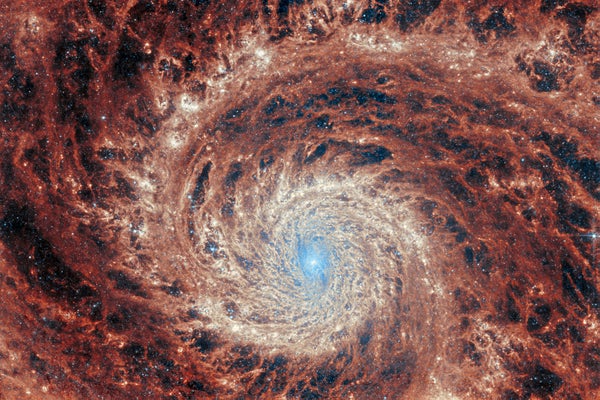The year 2023, like every other one before it—and, no doubt, every year to come—has had its crests of good news and its troughs of bad tidings. But one constant, reliable source of awe and beauty is the sky over our head. After journeys of mere seconds to billions of years, the light from astronomical objects in the cosmos rains down on all of us, and scientists have patiently photographed some of it to better understand the universe in which we live.
And every year we see new things, or old things in new ways, and I’ve been set the wonderful task of selecting my favorites and relaying them and their import to you. End-of-year lists, especially those displaying astronomical imagery, tend to be splashy and colorful. That’s understandable, but what they sometimes miss are the more subtle photographs, those that hide momentous discoveries in minor visual details or offer fresh perspectives on familiar objects. They may not leap off the page, but they still have an impact.
That’s what I’ve kept in mind while sorting through this year’s celestial treasure trove. This gallery is by no means complete, but it shows what I think are some of the most interesting astronomical portraits to have emerged in 2023.
On supporting science journalism
If you're enjoying this article, consider supporting our award-winning journalism by subscribing. By purchasing a subscription you are helping to ensure the future of impactful stories about the discoveries and ideas shaping our world today.
The Macabre Glow of Galactic Bones
No gallery such as this would be complete without something from the James Webb Space Telescope (JWST), our newest infrared eye on the sky. This monster observatory has already brought so many small revolutions to astronomy that picking one from the past year is no small task. Should it be a baby star throwing an immense tantrum or a massive old star shedding material at colossal rates before it inevitably explodes as a supernova? Or should it be a map of a mind-stomping 100,000 galaxies?
Well, how about something very, very different—such as the skeletal structure of a nearby galaxy’s intricate web of dust (as seen in the opening image above)?
Messier 51 (M51) is a spiral galaxy about 30 million light-years away that is face-on when viewed from Earth. A favorite of amateur and professional astronomers, it has a beautiful spiral structure and shows the effects of a smaller galaxy colliding with it. In the phenomenally sharp and decidedly eerie false-color view from JWST’s Mid-Infrared Instrument, shown above, we see countless clouds of cosmic dust in a skeletonlike pattern. Each of these clouds is made up of small grains of rocky and sooty carbon-based molecules expelled by dying stars. M51’s rotational motion combines with its complex gravitational field to sculpt these collective dust clouds into interconnected whorls; red areas show regions where dust is warmed by starlight, and yellow hues denote sites of active star formation. Astronomers captured this image to better understand how stars are born in stellar nurseries and how they evolve over time.
An Asteroid’s Moon Doubles Down
NASA’s Lucy spacecraft is currently in the main asteroid belt, cruising by its way to Jupiter—or, more accurately, to Jupiter’s orbit. Lucy’s mission is to study several asteroids sharing the huge gas giant’s orbit around the sun. Each asteroid has been nudged into position by a balance of Jupiter’s gravity and that of our star. The Lucy mission’s targets are called Trojan asteroids, and they’re leftovers from the early days of the solar system, like fossils of earlier times—hence Lucy’s moniker. It’s named after the eponymous Australopithecus afarensis fossil skeleton found in Africa in the 1970s.
As a way to test its navigational and imaging system on its way to the planet, the spacecraft was aimed to fly past a main belt asteroid. Known as Dinkinesh—the Ethiopian name for the Lucy fossil—this space rock is only about 800 meters across. Astronomers had been puzzled about the asteroid’s brightness fluctuations as seen from Earth, which were explained when Lucy saw that Dinkinesh had a moon! Such companions aren’t uncommon for asteroids, so while this was a surprise, it wasn’t exactly shocking.
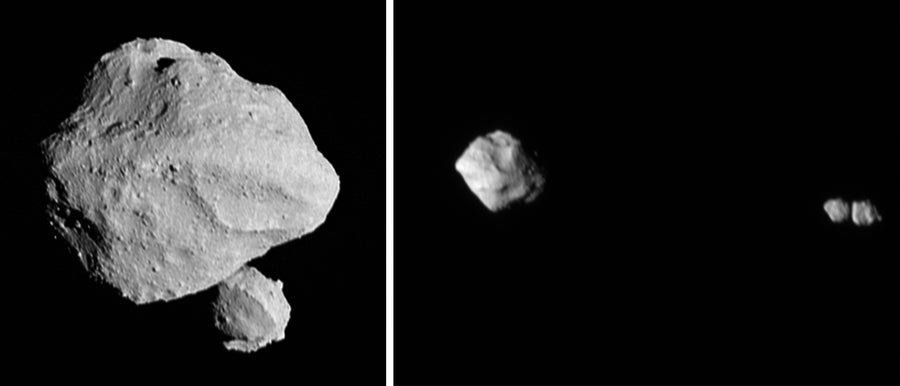
Credit: NASA/Goddard/SwRI/Johns Hopkins APL/NOIRLab (left); NASA/Goddard/SwRI/Johns Hopkins APL (right)
But then astronomers were, in fact, shocked to find they were seeing double: the moon itself is made up of two rocks just touching, called a contact binary! This is the first time anyone has seen a contact binary moon orbiting an asteroid moon like this, and theorists are already busy trying to figure out how it formed. What other secrets will this wonderfully named spacecraft see as it flies past more relics from our deepest planetary prehistory?
The Locked Time Capsule of the Solar System’s Past
Bennu is a potentially hazardous asteroid, a half-kilometer-wide space rock that has a cumulative 0.06 percent chance of hitting Earth two centuries from now. I’ll take those odds, but I’m also glad NASA also sent the OSIRIS-REx mission there to investigate.
Among its many mission goals, OSIRIS-REx was tasked with gathering samples of the material on and just beneath Bennu’s surface, most of which is thought to have scarcely changed in the eons since the asteroid’s formation near the dawn of the solar system. Bennu is thus a rocky time capsule from those bygone epochs, and scientists suspect other asteroids like it may have helped seed Earth with life’s essential ingredients shortly after our planet cooled. After a long, long journey, the flying-saucer-shaped sample return container, with its horde of Bennu bits, landed in the Utah desert in September 2023.
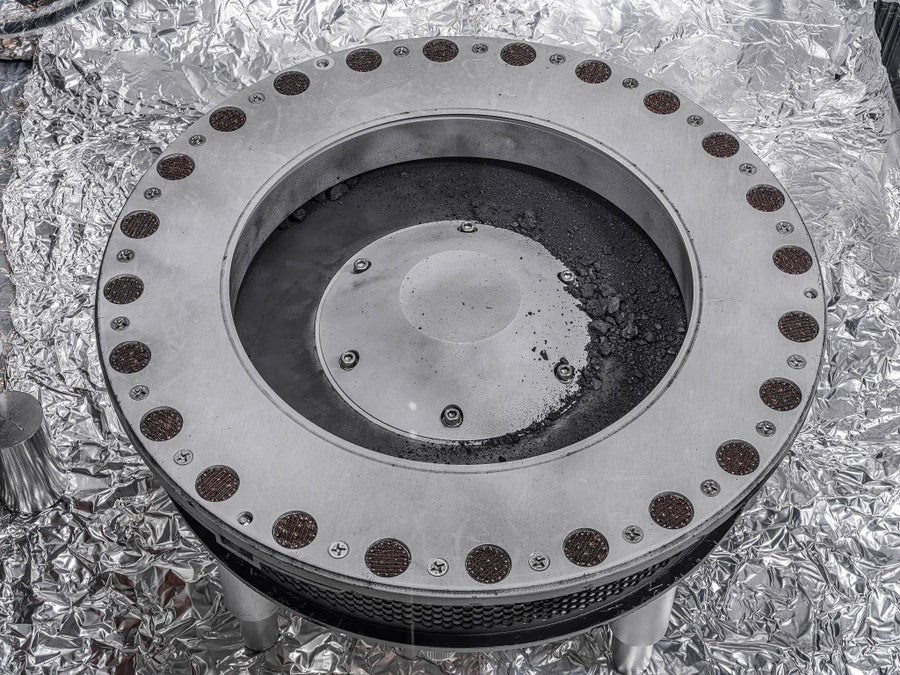
Scientists hoped to collect about 60 grams of material but may have actually captured several hundred. Exactly how much they have is still uncertain; two of the 35 fasteners holding the lid on the container are stuck, so mission personnel cannot fully open the apparatus. Engineers are working on making tools that can open it all the way.
Even so, the researchers were able to use tweezers to retrieve a small amount of the material inside, and together with stray asteroidal material that dusted the container’s exterior, they already have more than 70 grams to study. That’s more than enough for scientists to get an early taste of OSIRIS-REx’s cosmic bounty, and they’ve already found that the sample brought back from Bennu is rich in water and carbon alike. Ironically, this asteroid is showing us how its kind may have helped deliver life to our planet, even as they threaten it.
The Near, the Far and the Very, Very Far
Comet C/2020 V2 (ZTF) never got closer than about 280 million km from Earth, so it never brightened enough to be seen with unaided eyes. It was nonetheless a dramatic sight in telescopes, especially to expert astrophotographer Damian Peach. He waited until December 12, 2023, to take this shot, when the comet was moving through the constellation Grus (the Crane) and passing by three lovely spiral galaxies called NGC 7582, 7590 and 7599. This coincidental positioning frames all these objects perfectly.
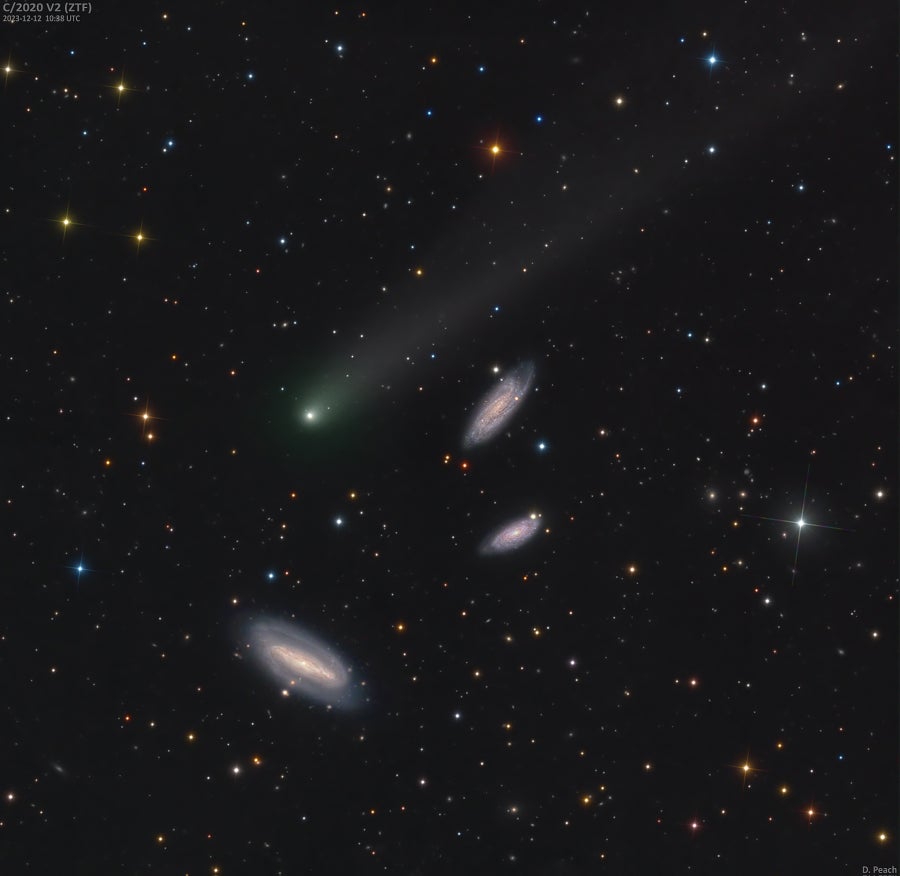
Credit: Damian Peach
It also gives us an uncanny sense of depth. At the time that Peach took this image, the comet was 500 million km from Earth. That’s a decent distance inside our own solar system, but it’s a much shorter distance than that of the background stars, which are quadrillions of kilometers farther away.
And that brain-melting distance is positively crushed by the gap between us and the three galaxies, which are around 70 million light-years away: that’s about 700 quintillion (700,000,000,000,000,000,000) km! The universe is deep.
Incidentally, the comet’s orbit is what’s called hyperbolic, meaning it has too much energy to be bound by the sun’s gravity. V2 is likely to escape the solar system entirely and slowly make its way into interstellar space. In a few million years it may very well be cruising the interstellar gulfs between the stars.
Dusty View of a Cosmic Beehive
Globular clusters are vaguely spherical collections of hundreds of thousands of stars all held together by their mutual gravity. They remind me of swarms of bees frozen in a snapshot by the way that the myriad stars buzz around their cluster’s center. More than 150 of these clusters orbit our Milky Way galaxy, most many tens of thousands of light-years away. But some are close enough to Earth that they’re visible to the naked eye.
At about 15,000 light-years away, Terzan 12 is too dim to be a naked-eye globular cluster. And its dimness isn’t caused by distance alone: it’s located very close in the sky to the Milky Way’s center, so we only see it through nearly opaque intervening clouds of cosmic dust.

One way to help pierce that veil to is to look for infrared light, which can pass through dust better than visible light can. Hubble Space Telescope has cameras that can detect infrared light (though not as well as JWST can), and its sharp vision picks the stars of Terzan 12 out of the murk.
Even then, though, the clouds aren’t smooth but patchy, and some thicker ones still manage to block Hubble’s view of the cluster’s left side. Stars there appear redder because the longer light’s wavelength is, the better it reaches us through that miasma. Observations such as this not only teach us about the star cluster but also about the density and location of the dusty fog lying near the Milky Way’s heart.
Bright Dawn, Big Telescope
In Chile’s Atacama Desert, at a gasp-inducing elevation of 3,046 meters above sea level atop the mountain Cerro Armazones, the European Southern Observatory is building the world’s largest optical telescope, aptly (if somewhat prosaically) named the Extremely Large Telescope, or ELT. Upon completion in 2028, its primary mirror will be an array of 798 hexagonal mirrors, each 1.5 meters across, working in concert within an accuracy of a few dozen nanometers to create a single reflecting surface spanning an incredible 39 meters.
For right now, though, while the telescope is being fabricated, so, too, is its massive dome. Eighty meters tall—the height of a 24-story building—and 88 meters across, the protective enclosure is still under construction.
But that doesn’t mean it’s too early for amazing photographs of the ELT. Situated on the peak of Cerro Paranal 33 km away, a photographer caught the sun rising behind what will soon be a 6,100-ton behemoth.
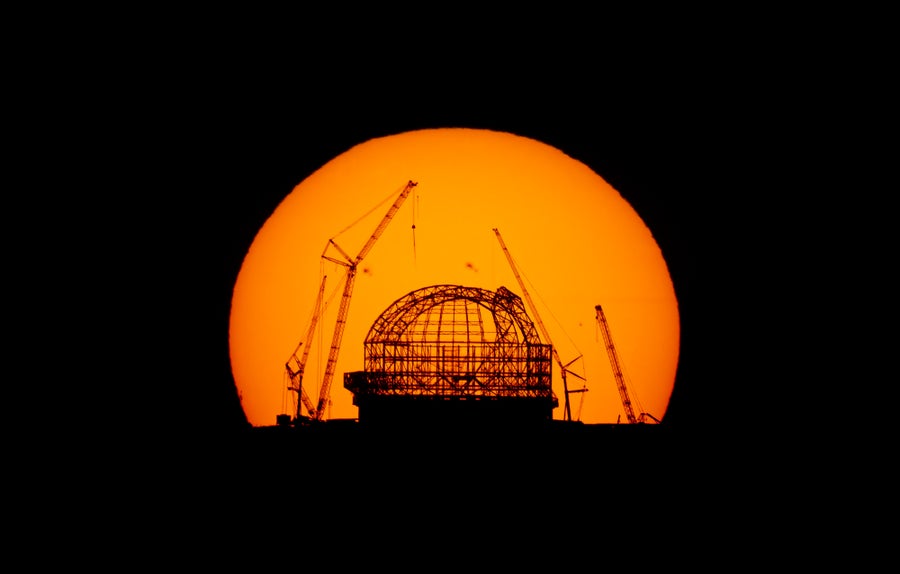
Credit: E. Garcés/ESO. Ack.: N. Dubost (CC BY 4.0)
This is a tricky shot because the azimuth (cardinal direction) of the sunrise changes every day, and getting the right alignment between the two mountains and our much more distant star on the horizon took exacting timing. This photograph was taken on August 29, 2023. Cranes frame the dome’s silhouette, and a few sunspots dot the face of the rising sun. Despite this promising dawn, the future isn’t necessarily bright for other projects to build similarly sized observatories: The difficult engineering and high cost of ELT may make it one of the last of overwhelmingly large ground-based telescopes humans ever build.
A View of a Solar Eclipse—From the Moon
On April 20, 2023, the moon passed directly between Earth and the sun, blocking our star from view to select observers in the Southern Hemisphere—a total solar eclipse. From Earth, the moon appeared as a dark disk as its shadow swept across the southern Indian and Pacific Oceans.
But what did it look like from the moon? The Japanese company ispace built a mission called HAKUTO-R that entered lunar orbit on March 21, 2023. The company deployed a lander that, unfortunately, was lost moments before its final descent to the surface. Just days earlier, however, it saw something no human has yet witnessed in person: the eclipsing shadow of the moon sweeping across the face of Earth from 380,000 km away.
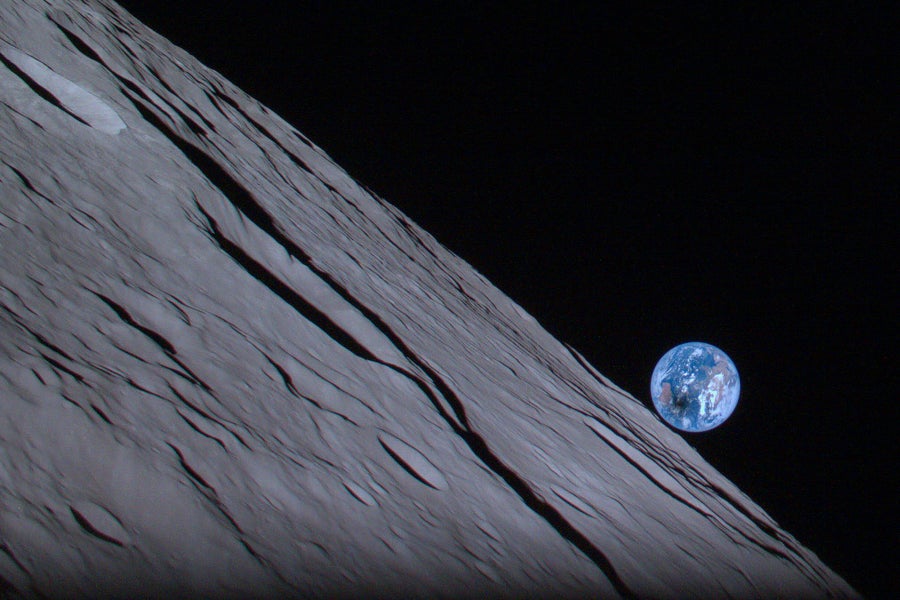
Credit: ispace, inc.
The moon’s gray, crater-pocked and forbidding surface dominates the view of the image, but our eyes are drawn inexorably to the mottled blue disk near the lunar limb (edge of the moon’s surface). Some white clouds can be seen, as well as brown splotches that are in reality Australia and part of Asia.
But look again: that dark discoloration marring Earth’s face near Australia is the shadow of the moon, cast back all that distance across space to intersect our planet’s surface, giving so many people the thrill of a lifetime in the form of a total solar eclipse.
We don’t yet have a proper name for this unique perspective. When the moon blocks the sun as seen from Earth, it’s a solar eclipse. When Earth blocks the sun as seen from the moon, we call it a lunar eclipse. But what do we call a view from the moon as its shadow sweeps across Earth—a “terrestrial eclipse”?
With human exploration of the moon advancing, we’ll need to nail that down. Or maybe we can just wait a little while; one day, maybe not too far in the future, people will experience this phenomenon for themselves. Perhaps we should leave the naming to them.
Storms as Large as Worlds
Jupiter is so big that it defies our puny human minds. Its diameter is 11 Earths wide, and more than 1,000 Earths would be needed to fill its volume. Its atmosphere is so deep that there’s no real solid surface; we only see its cloud tops. From Earth, Jupiter’s wide horizontal stripes that mark the gas giant’s atmospheric storms are a familiar sight to anyone who has peered through even a small telescope.
Earth and Jupiter orbit the sun in very nearly the same plane, and Jupiter’s axis is tipped a mere three degrees from perpendicular. This orientation has kept details of Jupiter’s poles hidden from us—that is, until NASA sent the formidable Juno spacecraft to orbit the gas giant.
Armored like a tank to shield it from Jupiter’s powerful magnetic fields, which accelerate charged particles to electronics-zapping energies, Juno is on a long, looping orbit that takes it from 8 million km above the cloud tops to just 4,200 km in altitude, where it speeds full tilt past Jupiter at 200,000 km per hour.
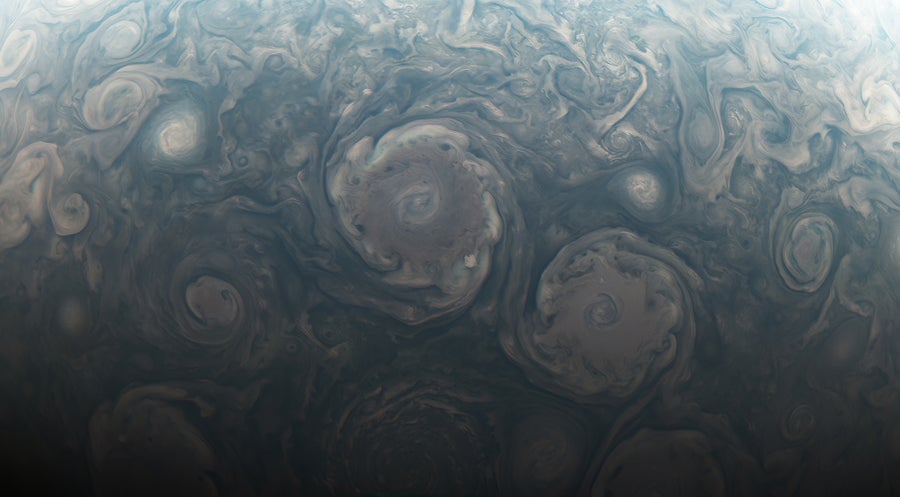
These breathtaking plunges send the spacecraft swooping over higher latitudes near Jupiter’s north pole, revealing sights unseen from Earth. In April, on its 50th pass over the planet, it took this shot of two huge cyclones whirling together. (Juno’s raw images from the pass were processed by software engineer Kevin M. Gill.)
Those cyclones are part of an octet of regularly-spaced vortices surrounding Jupiter’s pole, each more than 1,000 km wide, with a single central, larger cyclone sitting smack-dab on the pole that’s about 4,000 km wide. It’s not clear how these cyclones formed or why they’re stable; models of Jupiter’s atmosphere predict they should dissipate. But there they are, telling us that there are more things in the heavens than are dreamed of in our philosophy.
Clearly it’s up to us to dream bigger.
Every year Earth continues its turning, as does the churning ebb and flow of human affairs, for better or worse. One thing that helps me keep my resolve through it all is our shared and enduring ability to look in wonder up at the beauty of the heavens. Science and art are two ways we understand our world—our universe—and astronomy is the best of both.
An excerpt of this article entitled “Lunar Lens” was adapted for inclusion in the March 2024 issue of Scientific American.
